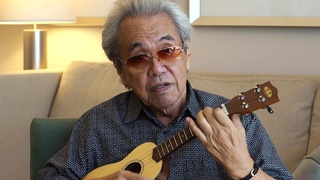Interviews
Differences between American and Japanese taiko
1985, Tsukuba World Expo, I represent as United States for NHK interview. So, [they] said, “Tanaka Sensei, how you feel [about] Japanese taiko? Wah, wah, wah…” First thing I said, “They play nice taiko. Good costume.” That time, Japanese economy, economic is very good, so they spend, you know. But the American taiko group, they make their drums themselves and the costume themselves. So American taiko group [is] not as fancy as Japanese taiko group, but American taiko group has more spirit, more appreciation because they made their drums themselves, so they take care drum good. But Japanese group—town or city—they are budget they buy the nice drum. So please beat taiko. I think spoiled. That’s what I said.
So for American-born Japanese to play taiko is not only fun, but through taiko or beat taiko, they express themselves—their identity. I’m not Sansei, so I can’t exactly represent their feeling. But to make a group here and to make a taiko group in Japan…totally different. I think United States people is more down to earth, down to earth. Even though taiko shape not good as expensive taiko, but values—sense of values is different. That’s [what] I told 20 years ago.
Date: January 27, 2005
Location: California, US
Interviewer: Art Hansen, Sojin Kim
Contributed by: Watase Media Arts Center, Japanese American National Museum.
Explore More Videos

Re-examining Identity
(1941-2018) Japanese Canadian photojournalist and activist

How he got on the All-Navy show on Ed Sullivan
(b. 1934) Ukulele player from Hawaii





Conflicted about immigrating to America (Japanese)
(b. 1925) War bride

Defining "Nikkei"
(1941-2018) Japanese Canadian photojournalist and activist

Unique Identity from Having Multiple Backgrounds
(b. 1938) Philipines-born hikiagesha who later migrated to the United States.

Growing up Japanese in Hawaii
(b. 1952) Former banking executive, born in Hawaii



Parents identification as Peruvian Okinawan
Okinawan American whose parents are from Peru.

Okinawan cultural appreciation
Okinawan American whose parents are from Peru.

Prejudice against Okinawans from mainland folks
Okinawan American whose parents are from Peru.
